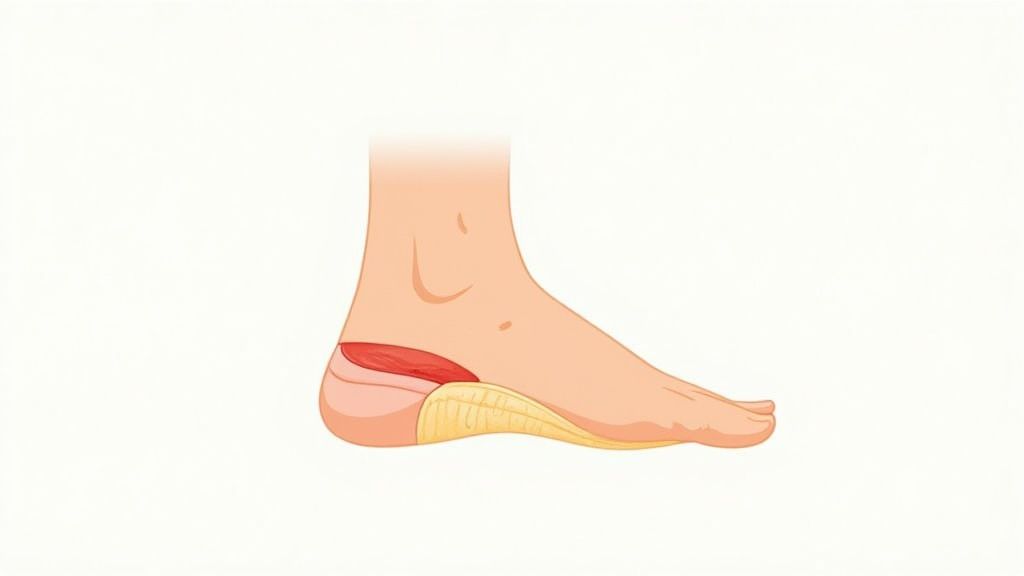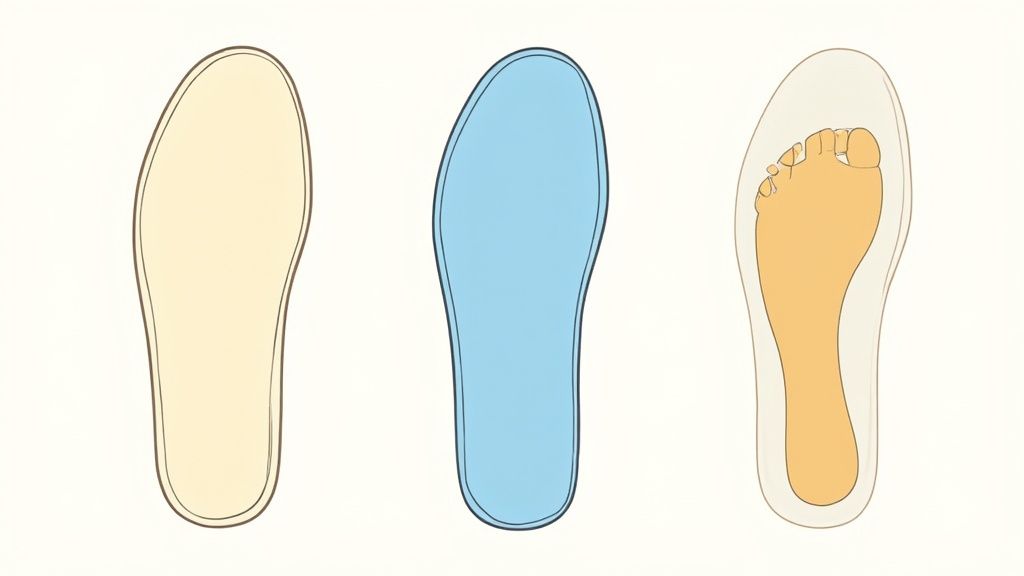If you've ever felt that sharp, stabbing pain in your heel first thing in the morning, you know how desperate you can be for relief. The right insoles for plantar fasciitis can be a game-changer. They're designed to tackle the root mechanical problems causing your pain, giving your foot the support and cushioning it needs to finally heal.
Why Insoles Work for Plantar Fasciitis Pain

To really get why insoles are so helpful, you have to understand what’s going on inside your foot. The culprit is a thick, fibrous band of tissue called the plantar fascia. It runs along the bottom of your foot, connecting your heel to your toes, and its main job is to support your arch and absorb shock.
When you put too much stress on this ligament—maybe from your feet rolling inward (overpronation), having particularly high arches, or just from being on your feet all day—it gets overworked. This leads to tiny tears and inflammation, which is the classic sign of plantar fasciitis. With every step, you're just re-injuring that inflamed tissue, creating a miserable, painful cycle.
How Insoles Provide Relief and Support
A good insole for plantar fasciitis isn't just a squishy piece of foam. It's a functional support system that corrects the mechanical issues causing the pain in the first place.
Here’s a breakdown of how they bring relief:
- Arch Support: This is the big one. An insole that properly supports your arch takes a massive amount of strain off the plantar fascia. This simple lift gives the ligament a chance to rest and heal, even when you can't stay off your feet.
- Heel Cushioning and Control: A deep, cupped heel is crucial. It cradles the heel bone, absorbing the jarring impact of each step. It also helps control pronation, stopping that inward roll that so often contributes to the problem. If you want to dig deeper into this, we have a whole guide on https://samuraiinsoles.com/blogs/articles/insoles-for-heel-pain.
- Better Alignment: By supporting the arch and stabilizing the heel, a quality insole helps put your foot back into a more neutral, natural position. This fixes biomechanical imbalances that can cause a chain reaction of pain up into your knees, hips, and even your back.
A supportive insole works by distributing pressure evenly across your entire foot. This means no single area, especially your inflamed plantar fascia, has to take the full force of your body weight.
It's also worth noting that what you do off your feet matters, too. Supporting your body's healing process from the inside out by incorporating more anti-inflammatory foods into your diet can make a real difference in managing inflammation and pain.
How to Choose the Right Insoles for Your Feet

Walking into a store and seeing a wall of insoles can feel overwhelming. With so many choices, how do you find the one that will actually help your plantar fasciitis? It really comes down to matching the insole to your foot shape, your daily routine, and just how much your heels are hurting.
Let's break it down. You’ll generally run into three types of insoles: soft cushioned ones, semi-rigid orthotics, and fully custom orthotics. Each has its place, and understanding the pros and cons is the key to getting you back on your feet without pain.
Soft Cushioned Insoles for General Comfort
You’ve probably seen these everywhere—the soft, squishy gel or foam inserts you can grab at any pharmacy. Their main job is to add a layer of cushioning and absorb some of the shock from walking and standing. If you're on your feet all day, they can provide some nice, immediate comfort.
But here’s the catch: they don't do much to fix the underlying problem causing your plantar fasciitis. Think of them as soft pillows for your feet. They feel good for a little while, but they lack the firm arch support needed to relieve the strain on your plantar fascia ligament. They're a decent starting point for mild foot fatigue, but they won't cut it for moderate to severe heel pain.
Semi-Rigid Orthotics for Targeted Support
This is the sweet spot for most people struggling with plantar fasciitis. Semi-rigid orthotics offer the best mix of true support, comfort, and affordability. They’re built with a firm, yet flexible, support shell (often plastic or a composite material) and are topped with a comfortable cushioning layer.
These insoles are designed to do two critical things:
- Support your arch properly to take the pressure off that strained plantar fascia.
- Stabilize your foot with a deep heel cup to control overpronation (when your foot rolls too far inward).
Instead of just masking the pain, they address the root biomechanical issues. For instance, our Samurai Insoles are designed in an orthotic lab to deliver this kind of medical-grade support. They give you the structure you need to fight heel pain without the high price and long wait for custom-made options.
To make things a bit clearer, here’s a quick comparison of the different types of insoles you'll encounter.
Comparing Insole Types for Plantar Fasciitis
This table should help you quickly see how the three main categories stack up, making it easier to decide which direction to go based on your needs and budget.
| Insole Type | Best For | Support Level | Average Cost | Key Feature |
|---|---|---|---|---|
| Soft Cushioned | Mild foot fatigue, general comfort | Low (Cushioning only) | $10 - $30 | Shock absorption |
| Semi-Rigid | Moderate to severe plantar fasciitis | Medium-High (Structural) | $40 - $80 | Arch support & heel stability |
| Custom Orthotics | Severe biomechanical issues, foot deformities | High (Personalized) | $300 - $800+ | Molded to your exact foot shape |
Ultimately, semi-rigid orthotics provide the targeted support that most people need to find lasting relief from plantar fasciitis.
Custom Orthotics for Complex Cases
When over-the-counter options just aren't enough, you might need to see a podiatrist for custom-molded orthotics. These are the top-tier solution, created from a precise mold of your feet after a thorough gait analysis.
Custom orthotics are typically the last resort, reserved for people with severe foot deformities, complex biomechanical problems, or those who have tried high-quality semi-rigid insoles without success.
While they offer an incredibly precise fit, they are also very expensive, often running several hundred dollars and frequently not covered by insurance. The good news is that a huge number of people get fantastic results from a well-designed, pre-molded orthotic. In fact, as highlighted in market studies on Straits Research, orthotic insoles are used to treat a whole host of foot ailments beyond plantar fasciitis—like bunions and metatarsalgia—by correcting biomechanics and improving overall mobility.
Getting the Perfect Fit for Your New Insoles

So, you've picked out a great pair of insoles for plantar fasciitis. That's a huge step, but we're not quite at the finish line. An insole that doesn't fit right is almost as useless as having no insole at all.
If it slides around or bunches up under your toes, it can’t provide that targeted support your fascia needs. Worse, it might even create new hot spots and pressure points. Getting a snug, perfect fit is what truly unlocks the pain relief you're looking for.
Your first move is to pull out the factory liners that came with your shoes. Most of the time, they're just held in with a few dabs of weak glue and come out with a gentle tug. Don't toss them! This flimsy little liner is your secret weapon for getting a custom-like fit from your new orthotic.
Use the Original Liner as a Guide
Lay the factory liner flat on top of your new, more substantial insole. The key here is to line up the heels perfectly. You'll probably see that your new insole is a bit longer and wider—that's totally normal and done on purpose so it can be trimmed to fit a range of shoe sizes.
With the heels flush, grab a pen or a silver marker (which shows up great on dark materials) and trace the outline of the original liner onto your new one. This traced line becomes your cutting guide.
Pro Tip: When in doubt, cut a little less than you think you need. You can always trim more off, but you can't glue it back on. I always suggest cutting just outside your traced line on the first pass, just to be safe.
Trim for a Snug Fit
Now, with a sharp, sturdy pair of scissors, carefully cut along the line you drew. Try to make your cuts as clean and smooth as possible, especially around the curve of the toe. Any jagged edges could create an annoying ridge you'll feel with every step.
Once you’ve made the first cut, it’s time for a test fit. Slide the trimmed insole into your shoe. Make sure you push it all the way to the back so the heel is seated firmly. Now, press down on the front half of the insole. Does it buckle or create a ripple? If so, it’s still a hair too big.
No problem. Just pull it back out, see where it was bunching, and trim a tiny sliver of material from that area. Repeat this little dance of "trim and test" until the insole lies completely flat inside the shoe, from heel to toe, with no gaps. A perfect fit means it stays put when you walk.
This need for a better, more personalized fit is a big deal in the foot care world. It's what's pushing the entire industry forward. In fact, the market for foot orthotic insoles was valued at USD 4.22 billion in 2024 and is projected to hit USD 7.16 billion by 2032. Much of that growth comes from new tech that makes customization easier. You can see the full breakdown of these trends over at Fortune Business Insights.
What to Expect During the Break-In Period

So you've got your new insoles. It’s tempting to slide them into your shoes and expect immediate, all-day comfort. I get it. But hold on for a second—your body needs time to catch up.
For months, or even years, your feet have been functioning in a less-than-ideal, unsupported way. When you introduce a proper arch support, you're not just changing your feet; you're changing the alignment of your entire body, from your ankles all the way up to your back. This is a big change, and rushing it is a common mistake that can actually cause more discomfort.
Think of it this way: you wouldn't go from the couch to running a 5K on day one. You have to train your body. Breaking in new insoles for plantar fasciitis works the same way. A slow, steady approach is the secret to making them work for you.
Your Actionable Break-In Schedule
The goal here is to gradually introduce your feet to this new support system. This lets your muscles and ligaments adapt without getting overwhelmed. I've found a simple schedule works best for most people.
- Days 1-2: Start small. Wear the insoles for just 1-2 hours a day. This is perfect for light activities like walking around the house or a quick trip to the store. Afterward, swap them out for your old inserts.
- Days 3-5: Now you can bump it up to 3-4 hours of wear time. Maybe you keep them in for the first half of your workday and then switch them out.
- Days 6-7: Let's push it a bit more to 5-6 hours. By now, you should be able to get through most of your day with the new insoles in place.
- Week 2 and Beyond: From here, just add another hour of wear time each day. Before you know it, you'll be wearing them all day without a second thought. Most people are fully adjusted within 7 to 14 days.
This isn't a race. This gradual process prevents you from shocking your system and helps your body welcome its new, healthier alignment.
Normal Soreness vs. Red Flags
It's completely normal to feel a little something new in your feet at first. You might notice some mild muscle fatigue in your arches, almost like they've had a light workout. That’s a good sign! It means the insoles are engaging muscles that haven't been doing their job.
But you absolutely need to know the difference between this normal adjustment period and a real problem.
Normal adjustment soreness: Think of a dull, general ache in your arch muscles. It should feel like muscle tiredness, and it typically goes away not long after you take the insoles out for the day.
Red flag pain: This is different. We're talking about sharp, stabbing, or concentrated pain in one specific spot. Numbness, tingling, or blisters are also major red flags. This isn't something to push through; it means the insole is creating a pressure point and is not a good fit for your foot. If you feel this kind of pain, stop wearing them immediately and figure out if you need a different size or shape.
Making Your Insoles Last Longer and Work Better
You've invested in a good pair of insoles for plantar fasciitis, which is a huge step toward getting back on your feet without pain. But that’s only half the battle. To keep that relief coming, you need to give your insoles a little TLC. Proper care keeps them working as they should, ensuring your feet get the consistent support they need to heal.
I like to think of insoles like the tires on a car. They take a beating every single day. If you don't maintain them, they wear out, and their performance suffers. Worn-out, dirty, or damp insoles can’t do their job, which could unfortunately mean a return of that all-too-familiar heel pain.
Simple Cleaning and Drying Techniques
Most quality insoles, especially the semi-rigid kind, are tough, but they absolutely do not belong in your washing machine. The intense heat and tumbling action can completely warp the supportive structure and ruin the foam cushioning. Luckily, a quick hand wash is all it takes to get them clean.
Here’s my go-to method:
- First, take the insoles out of your shoes.
- Get some cool water and mix in a little bit of mild soap.
- Gently scrub the insoles with a soft cloth or brush, paying extra attention to any really dirty spots.
- Rinse them well under cool water until all the soap is gone.
Drying them the right way is just as crucial as washing them. Whatever you do, don't toss them in the clothes dryer or stick them on a radiator. Direct heat is the enemy—it can make the materials shrink, crack, or become brittle.
The Best Method: Just pat them dry with a towel, then leave them out to air dry completely at room temperature. This simple step not only preserves their shape and function but also helps prevent smelly bacteria from growing.
Spotting the Signs of Wear and Tear
Even the best insoles won’t last forever. Over time, the materials that cushion your feet and support your arches will naturally compress and break down. Knowing when it’s time for a replacement is key to keeping plantar fasciitis from creeping back into your life.
Keep an eye out for these tell-tale signs:
- Visible Damage: Are there cracks in the arch support? Is the top cover peeling off? These are clear red flags.
- Flattened Cushioning: If the foam feels flat and doesn’t bounce back like it used to, it's lost its shock-absorbing power.
- Reduced Support: This is often the first clue. If you start feeling those old aches and pains in your heel or arch again, your insoles are likely worn out.
The demand for effective foot support solutions is growing, and for good reason. The global foot orthotic insoles market was valued at around USD 3.36 billion back in 2022 and continues to expand. You can see more on this trend in a market report from Grand View Research.
For more tips on managing your condition for good, take a look at our complete guide on how to fix plantar fasciitis for lasting relief. A fresh, supportive pair of insoles is a non-negotiable part of any long-term recovery plan.
Got Questions About Your Insoles? Let's Talk.
So, you’ve picked out your new insoles. That’s a huge first step! But now, you probably have a few questions about what comes next. It’s completely normal to wonder about the little details as you start this journey.
We’ve heard just about every question in the book when it comes to insoles for plantar fasciitis. Here are the most common ones we get, along with some straight-up answers to help you feel confident.
Can Insoles Actually Cure Plantar Fasciitis?
This is the big one, and it's a great question. The honest answer is that insoles are an incredibly powerful tool for managing your pain and creating the perfect environment for your foot to heal. They work by supporting your arch and absorbing the shock that was constantly aggravating your plantar fascia. Taking that daily strain away is what finally gives the tissue a chance to rest and recover.
But they work best as part of a team effort. Think of your insoles as the star player, but they can't win the game alone. For a true, lasting recovery, you’ll want to pair their daily support with other proven strategies—things like targeted stretches, wearing the right shoes, and just giving your feet a break.
Insoles stop the constant re-injury, while these other habits help speed up the healing.
Should I Choose Firm Support or Soft Cushioning?
It's a classic debate: should you go for a soft, gel-like insole or something with firm, structured support? The right choice really depends on what you're trying to solve.
- Soft, Gel-Based Insoles: These are amazing for immediate comfort. If you're on your feet all day on hard floors and just feel achy and tired, a soft insole can feel like walking on a cloud.
- Firm, Semi-Rigid Insoles: These are the real workhorses for tackling the root cause of plantar fasciitis. They are designed to control the mechanics of your foot, addressing issues like overpronation that put stress on the ligament in the first place.
For plantar fasciitis, a hybrid approach is usually the sweet spot. You want an insole with a firm, supportive arch and a deep heel cup for control, but with some smart cushioning placed in high-impact areas for comfort.
The most effective insoles don't just cushion the pain; they correct the problem. A firm structure is essential for taking the strain off the plantar fascia ligament, which is the key to long-term relief.
Do I Really Need Insoles in All My Shoes?
In a perfect world, yes. For consistent, lasting relief, the goal is to give your foot continuous support. Every step you take in a flat, unsupportive shoe can feel like a step backward in your recovery.
This is especially critical for the shoes you live in—your work shoes, your go-to sneakers, your walking shoes. A lot of people find it easier to grab a few pairs of their favorite insoles so they aren't constantly swapping them out. It’s a small investment that pays off with uninterrupted support and a faster path to feeling better.
Of course, they won't fit into every single shoe, like slim dress shoes or sandals. On those days, just do your best to limit your time in them. It's the consistency of support that really keeps the pain from coming back.
Even your sleep can affect healing, as the fascia often tightens up overnight. For anyone dealing with that sharp morning pain, learning how to sleep with plantar fasciitis by using supportive tools at night can be a total game-changer.
How Long Until I Feel a Real Difference?
You’ll probably feel some relief right away. That immediate "ahhh" feeling from the extra cushioning is a great start.
But the real, deep-down healing—the kind that comes from correcting your foot’s alignment—takes a little more time. Your body needs to adjust to its new, healthier posture. Most people tell us they notice a major drop in their daily heel pain after about two to four weeks of wearing their insoles consistently all day.
The key is just a little patience. Stick with it.
Are you ready to stop letting foot pain dictate your day? At Samurai Insoles, we've designed orthotics that deliver the firm support and targeted cushioning you need to fight plantar fasciitis. Experience the relief for yourself by checking out our insoles at https://samuraiinsoles.com.



